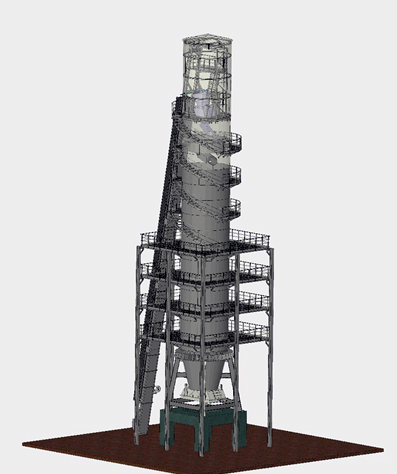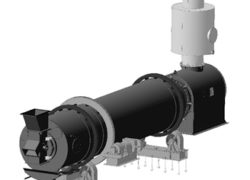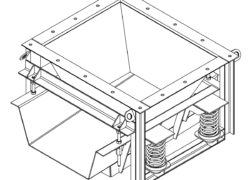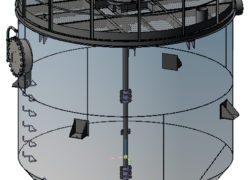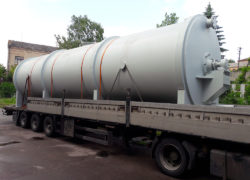General Information:
– shaft lime-gas kiln PShI-150, hereinafter – kiln, is a process equipment for the sugar industry and is designed to produce lime and carbonatation (kiln) gas in sugar factories by means of limestone calcining.
– kiln is installed in the lime-gas unit of a sugar factory in accordance with duly approved project documentation.
Description
| No. | Designation | MU | PShI -150 |
| 1. | Technical performance on СаО | t/hour | 150 |
| 2. | Technical performance on carbonatation gas | m3/hour | 12000 |
| 3. | СО2 content in carbonatation gas, % | % | 34-38 |
| 4. | Limestone calcining degree | % | 90-92 |
| 5. | Temperature of bleed carbonatation gas | °С | 100-120 |
| 6. | Temperature of discharged lime | °С | Т ambient + 50 |
| 7. | Specific volume of lime | t СаО/m2 per day | 12.5 |
| 8. | Specific reference fuel consumption per 1 ton of CaO | kg/t | 128-145 |
| 9. | Outer diameter of kiln | m | 5.2 |
| 10. | Inner diameter of kiln | m | On kiln lining |
| 11. | Useful height of kiln shaft, no less | m | 18 |
| 12. | Overall dimensions (excluding barrel of skip hoist, service platforms and gas extraction pipeline), max. – diameter – height |
mm |
6 270 |
| 13. | Weight of metal in the article, max. | kg | 90 000 |
Scope of supply
Scope of supply includes:
1) shaft lime-gas kiln PShI-150, manufactured and equipped in accordance with the specification of the assembly drawing – 1 set.
2) passport PShI-150 PS– 1 copy.
The kiln is supplied unassembled in individual components according to the Table 1.
Table 1. Components of kiln PShI-150
| No. | Designation of equipment components | Number of sets, pcs. | Weight (approximately), kg |
| 1 | Loading and distribution device | 1 | 3100 |
| 2 | Discharging device | 1 | 2850 |
| 3 | Barrel of skip hoist | 1 | 5850 |
| 4 | Bucket of skip hoist | 1 | 900 |
| 5 | Shaft | 1 | 35000 |
| 6 | Ladders and service platforms | 1 | 14500 |
| 7 | Bearing member | 1 | 21100 |
| 8 | Skip hoist winch | 1 | 1250 |
| Total | 84550 |
- On request of the Customer (Buyer), incomplete supply of kiln components and equipment is possible.
- Automation and control means are not included into kiln scope of supply (supplied separately).
- Lining, insulation materials are not included into kiln scope of supply (supplied separately).
Brief operation description: The shaft lime-gas kiln IPN-150 is a cylindrical shaft, lined inside with insulating (fireclay ShL – 0.4) and refractory (periclase PShPTs) bricks
The kiln lining ends on the level of the loading chute. Top of the lining prevents the baffle shell from destruction when kiln is charged.
To ensure the strength of the construction and to prevent the atmospheric air inflows, the shaft is enclosed within a metal enclosure, welded from steel sheets. The lower part of the shaft is cone-shaped.
The kiln shaft is supported by four supports located on the foundation.
Top of the shaft is closed with a flat sheet steel slab. The removal of kiln gas is carried out through the annular gas discharge duct created by the gap between the baffle shell and kiln lining.
At the top of kiln on the flat slab, loading and distribution device is mounted, consisting of a receiving hopper with a shutter cover and swivel chute. The uniformity of charge distribution in the kiln is provided by the swivel chute.
For discharging the lime from the kiln, at the bottom of the lower cone part of the shaft, a discharge unit mounted. Lime is discharged into a hopper located under the kiln, ‘table’. The drive transmits reciprocating motion to the ‘table’. By changing the frequency of the reciprocating oscillations, the discharge intensity can be regulated.
The kiln is charged with the bucket skip hoist.
In the barrel of skip hoist there are doors, to which the transition platforms from the kiln shaft platforms are connected, serving simultaneously as supports for skip hoist barrel. At the levels of kiln service platforms, in the shaft there are hatches to perform the lining and repair works.
Filling the bucket with a charge is controlled by an automatic control system.
The loading and distribution device should provide a reliable seal of the shaft and uniform distribution of limestone and fuel in its horizontal section. The gas removal conduit is located below the charge loading level, creating a rarefaction required for the inflow of air through the discharge unit in an amount required for fuel combustion in a combustion zone.
The discharge unit provides a uniform lime selection at a given temperature: both in time and in the section of the shaft, and also provides uniformity of air-sweeping through the shaft section.









